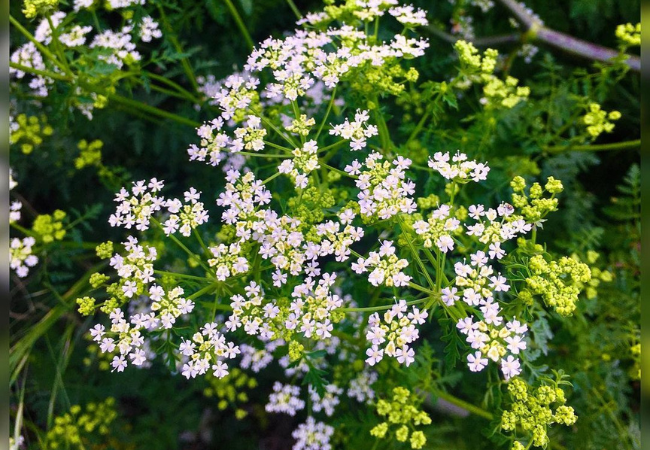Learn about the Hemlock plant, its flowers and important safety information. Discover the role of this plant in nature and history, while understanding why it’s crucial to identify and avoid this poisonous species.
When we talk about Hemlock, we’re not discussing a tree, but a group of flowering plants that can be both interesting and dangerous. This article will help you understand what Hemlock is, why it’s important to know about it and how to stay safe around it.
Here’s an easy and verified chart for Hemlock (Tsuga spp.):
| Category | Details |
|---|---|
| Botanical Name | Tsuga spp. |
| Common Name | Hemlock |
| Plant Type | Evergreen tree |
| Hardiness Zone | Zones 3-8 (depending on species) |
| Sun Exposure | Part shade to full shade |
| Soil Type | Moist, well-draining soil |
| Watering Needs | Regular; prefers moist conditions |
| Growth Habit | Pyramidal, conical |
| Height/Spread | Varies by species; typically 40-70 feet tall, spread of 20-40 feet |
| Special Features | Soft, feathery foliage; cones; provides dense shade; deer resistant; important in forestry; some species used in landscaping and as ornamentals |
What is Hemlock?

Hemlock is a type of flowering plant that belongs to the carrot family. There are different kinds of Hemlock, but the most common ones in the USA are Poison Hemlock and Water Hemlock. These plants can grow quite tall, sometimes reaching up to 8 feet high.
Key Features
- White, small flowers that grow in clusters
- Fern-like leaves
- Hollow, purple-spotted stems
- Strong, unpleasant smell
Where Does Hemlock Grow?
Hemlock can be found in many parts of the USA. It often grows in:
- Wet areas near streams or ponds
- Open fields
- Along roadsides
- Disturbed areas like construction sites
The U.S. Forest Service provides more information about where these plants typically grow.
Why is Hemlock Dangerous?
It’s very important to know that all parts of the Hemlock plant are poisonous. This includes the flowers, leaves, stems and roots. Even touching the plant can sometimes cause skin reactions in some people.
The poison in Hemlock can cause:
- Nausea and vomiting
- Difficulty breathing
- Paralysis
- In severe cases, it can even be fatal
If you think you’ve touched or eaten Hemlock, contact the Poison Control Center immediately.
Identifying Hemlock
Knowing how to identify Hemlock is crucial for safety. Here are some tips:
- Look for white flowers in umbrella-shaped clusters
- Check for purple spots or streaks on the stems
- Notice the fern-like leaves
- Be aware of the strong, unpleasant smell
Remember, Hemlock can look similar to some edible plants like Queen Anne’s Lace or Wild Carrot. Always be sure before touching or eating any wild plant.
Hemlock in History and Culture
Despite its dangers, Hemlock has played a role in history:
- In ancient Greece, it was used to carry out death sentences
- Some Native American tribes used small amounts for medicinal purposes
- It has been mentioned in literature and mythology
The Smithsonian Institution has more information about poisonous plants in history and culture.
Ecological Role of Hemlock
Even though Hemlock is dangerous to humans, it does have a place in nature:
- Some insects can eat Hemlock without being harmed
- It can help prevent soil erosion in wet areas
- The plant is part of the natural ecosystem in many areas
Controlling Hemlock
If you find Hemlock on your property, it’s best to remove it safely. Here’s how:
- Wear protective clothing, including gloves and long sleeves
- Cut the plant at the root level
- Dispose of it in plastic bags
- Never burn Hemlock, as the smoke can be toxic
For more detailed removal instructions, check the U.S. Department of Agriculture guidelines.
Hemlock is a fascinating but dangerous plant. While it’s important to appreciate all parts of nature, it’s equally crucial to understand the risks associated with some plants. By learning to identify Hemlock and knowing its effects, you can keep yourself and others safe while enjoying the outdoors.
Remember, if you’re ever unsure about a plant, it’s best not to touch it. Stay curious, stay informed and stay safe in nature!
For more gardening tips and plant care guides, visit usagardenhub.com.


Your writing style is cool and I have learned several just right stuff here. I can see how much effort you’ve poured in to come up with such informative posts. If you need more input about Social Media Marketing, feel free to check out my website at Webemail24
Simply desire to say your article is as astonishing.
The clearness on your publish is simply excellent and i could suppose
you are an expert on this subject. Well along with
your permission allow me to snatch your RSS feed to stay updated with drawing close post.
Thank you one million and please carry on the rewarding work.
May I simply say what a comfort to discover somebody who actually knows what they are talking about online.
You actually know how to bring a problem to light and make it important.
More people need to look at this and understand this side of the story.
I was surprised you are not more popular since you surely have the gift.
It’s remarkable to go to see this site and reading the views of
all friends regarding this article, while I am also zealous of getting experience.